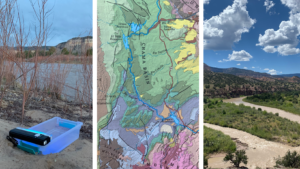
Four years of water and aquatic insect sampling coordinated by New Mexico Wild along the 24.6-mile Wild and Scenic stretch of the Rio Chama has shown the river is home to a robust community of aquatic insects and overall good water quality for the region. However, results also found some declines in aquatic insects that warrant further study.
The goal of the study, which covered the river between El Vado Dam and Big Eddy Take-Out just above Abiquiu Reservoir, is to gain a better understanding of the river ecosystem resiliency through the relationship between flow and sediment management at El Vado Dam, water characteristics and macroinvertebrate diversity.
The project was carried out in partnership with volunteers from the boating community who collected hundreds of samples and the U.S. Bureau of Reclamation WaterSMART Program. It was based on the successful U.S. Geological Survey’s Bug Flows citizen science project on the stretch of the Colorado River that flows through the Grand Canyon below Glen Canyon Dam. A similar project has also been conducted on the San Juan River, which is a comparable reach to the Rio Chama.
These past four years have been a particularly important window in which to conduct this experiment because major repairs are being done on El Vado for the first time in decades, temporarily requiring reservoir storage reduction and the use of different release outlets. Water management regimes at the dam create flow characteristics and macroinvertebrate habitats that influence the health of the wider riverine ecosystem. Macroinvertebrates’ place in the food chain and their sensitivity to pollution, temperature, turbidity and other factors make them key indicators of the Rio Chama’s health, and data about them can suggest areas for improvement in water management. The study has been able to establish baseline water quality conditions under existing dam operations, collect water quality data during the work at the dam and then compare those two datasets to determine the ecosystem impacts of the two different flow regimes.
Our results point to a strong difference in conditions between 2020 before repairs began and 2021–2022. Recent modeling of data from the much larger dataset on the Colorado River has indicated that lags in impacts on aquatic insect populations are possible. The effect of an environmental change may not appear until the summer after a stressor or when eggs have hatched, matured, and become susceptible to sampling capture. In other words, the effects of maintenance on El Vado Dam may not even be present in the 2023 Rio Chama data but might be evident in 2024 or future years.
The study also concluded that an additional diversity of insects is likely present in the Rio Chama and that identifying them becomes more likely with additional years of sampling. New Mexico Wild hopes to continue the community science project. Please check our website for details of the next phase and upcoming volunteer opportunities.
Thank you to Rebecca Neal, Rhett Sanders-Spencer, Dillon Zehnder, Dr. Jeffrey Muehlbauer, Dr. Rebecca Bixby, and Dr. Michael Harvey for your contributions to this project.
If you plan to float the Rio Chama this summer and would like to volunteer, reach out to dillon@nmwild.org to learn more and sign up to participate in this important Citizen Science project!

